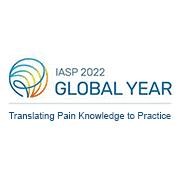This webinar was presented on April 5, 2022. Thank you to all who attended. The link to the recording is available here.
This webinar focused on lacosamide, a Food and Drug Administration-approved treatment for epilepsy, and how insights from the genetic analyses of pain patients led to its investigation for use in the management of neuropathic pain.
This event featured a presentation by Karin Faber, MD PhD, Maastricht University, the Netherlands, and was moderated by Heike Rittner, MD, University Hospital of Würzburg, Germany.
Here is an abstract from Dr. Faber:
Small-fiber neuropathy (SFN) is a peripheral neuropathy of the thinly myelinated Aδ-fibers and unmyelinated C-fibers, and is associated with multiple underlying conditions. Gain-of-function mutations in voltage-gated sodium channels (NaVs) have been reported in about 15% of patients with SFN. NaV1.7, NaV1.8, and NaV1.9, encoded by the genes SCN9A, SCN10A, and SCN11A, respectively, are preferentially expressed in dorsal root ganglion (DRG) neurons and their peripheral axons.
Lacosamide is a functionalized amino acid which binds to fast-inactivated NaV1.7 with slower kinetics than classical sodium channel blockers. Since pain in SFN is produced by inappropriate firing of DRG neurons, the NaV channels in these neurons would be expected to be in at least a partially inactivated state, so that lacosamide would be expected to bind with and inhibit these channels, thus attenuating the firing of DRG neurons.
Based on this information, a randomized, placebo-controlled, double-blind, crossover-design study was performed in 24 patients with NaV1.7-related SFN. Lacosamide had a significant effect on pain, general well-being, and sleep quality.
As a next step, voltage-clamp recordings were used to evaluate the effects of lacosamide on five NaV1.7 variants from patients who were responsive or nonresponsive to treatment. It was demonstrated that lacosamide acts as a potent sodium channel inhibitor of Nav1.7 variants carried by responsive patients, via a hyperpolarizing shift of voltage dependence of both fast and slow inactivation and enhancement of use-dependent inhibition. By contrast, the effects of lacosamide on slow inactivation and use dependence in NaV1.7 variants from nonresponsive patients were less robust. Importantly, we found that lacosamide selectively enhances fast inactivation only in variants from responders.
In conclusion, the finding of NaV1.7 gain-of-function mutations in patients with small-fiber neuropathy has led to the development of a new treatment option and, more importantly, may serve as an example for future drug development and clinical trials.
About the presenter
 Karin Faber, MD PhD, is a full professor in neuromuscular disorders as well as the medical director of the Maastricht University Medical Center, the Netherlands. She has extensive experience in the neuromuscular field, especially in muscle neurodegenerative disorders and painful/small-fiber neuropathies. She is the head of the skin-biopsy lab in Maastricht, which published the largest normative values worldwide, and helps to lead ongoing painful/small-fiber neuropathy randomized trials and all research activities in the neuromuscular field in Maastricht. She is authored on more than 160 peer-reviewed papers, including reviews and book chapters. Her research in the past five years has focused on the genetic causes of small-fiber neuropathy, more specifically on sodium channelopathies.
Karin Faber, MD PhD, is a full professor in neuromuscular disorders as well as the medical director of the Maastricht University Medical Center, the Netherlands. She has extensive experience in the neuromuscular field, especially in muscle neurodegenerative disorders and painful/small-fiber neuropathies. She is the head of the skin-biopsy lab in Maastricht, which published the largest normative values worldwide, and helps to lead ongoing painful/small-fiber neuropathy randomized trials and all research activities in the neuromuscular field in Maastricht. She is authored on more than 160 peer-reviewed papers, including reviews and book chapters. Her research in the past five years has focused on the genetic causes of small-fiber neuropathy, more specifically on sodium channelopathies.
About the moderator
 Heike Rittner, MD, is a clinician scientist and a professor at the Center for Interdisciplinary Pain Medicine in the Department of Anesthesiology at the University Hospital of Würzburg since 2008. She obtained her medical degree from the University of Vienna, Austria, and the University of Würzburg, Germany. After a postdoc at the Mayo Clinic, she completed her residency at the Charité, Berlin, and was board-certified in anesthesiology and pain medicine. Since 2021, she has headed the Center for Interdisciplinary Pain Medicine including the acute pain service as well as ambulatory, outpatient, and in-patient pain treatment.
Heike Rittner, MD, is a clinician scientist and a professor at the Center for Interdisciplinary Pain Medicine in the Department of Anesthesiology at the University Hospital of Würzburg since 2008. She obtained her medical degree from the University of Vienna, Austria, and the University of Würzburg, Germany. After a postdoc at the Mayo Clinic, she completed her residency at the Charité, Berlin, and was board-certified in anesthesiology and pain medicine. Since 2021, she has headed the Center for Interdisciplinary Pain Medicine including the acute pain service as well as ambulatory, outpatient, and in-patient pain treatment.
In parallel, she pursued her scientific career in understanding inflammatory and neuropathic pain generation and resolution in the peripheral nervous system. She employs advanced preclinical rodent models, state-of-the-art animal behavioral portfolios, and patients’ biomaterials, as well as in vitro cellular systems for barriers and neuronal structures to decipher these pathways. She has published more than 90 papers in peer-reviewed journals, and receives funds from German and European funding agencies.


